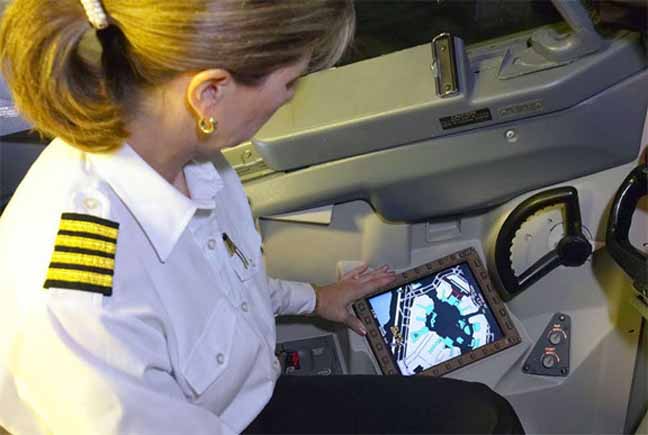 Next Generation Air Transportation System (NextGen) Concept
Next Generation Air Transportation System (NextGen) ConceptThe Federal Aviation Administration (FAA) accelerated its move toward a Next Generation Air Transportation System (NextGen) with contracts awarded to Boeing, General Dynamics and ITT on May 26 and performance requirements for aircraft tracking equipment announced May 28.
NextGen, to be completed by 2025, will rely heavily upon GNSS to increase capacity, efficiency, and safety in the National Air Space (NAS) while reducing adverse environmental effects.
The Federal Aviation Administration (FAA) accelerated its move toward a Next Generation Air Transportation System (NextGen) with contracts awarded to Boeing, General Dynamics and ITT on May 26 and performance requirements for aircraft tracking equipment announced May 28.
NextGen, to be completed by 2025, will rely heavily upon GNSS to increase capacity, efficiency, and safety in the National Air Space (NAS) while reducing adverse environmental effects.
Although not directly related, the activity came almost simultaneously with launch of the first GPS Block IIF satellite, which carries the new civil L5 "safety-of-life" signal that operates in the protected aeronautical radionavigation system (ARNS) RF band.
On May 26, the agency awarded the three NextGen contracts with a total value of up to $4.4 billion over 10 years for work that will demonstrate NextGen procedures in real time on a large scale within the current air traffic system.
The following day FAA announced performance requirements for aircraft tracking equipment — so-called automatic dependent surveillance—broadcast (ADS–B) technology — that will be required under NextGen. ADS–B uses GPS signals to more accurately identify the aircraft’s location throughout the flight than the current surveillance systems.
The rule was published in the May 28 Federal Register.
The FAA published a comprehensive NextGen workplan last year and the Office of Aviation Safety published its own NextGen workplan earlier this year. Both are available at the FAA’s NextGen website.
With a 2025 horizon for completion, NextGen would transform today’s radar-based air traffic control (ATC) system into a satellite-based system. In March, FAA published a fact sheet on its goal for performance-based navigation (PBN) that would implement satellite-based approaches called “area navigation” (RNAV) and “required navigation performance” (RNP) to optimize approach and landing at the nation’s airports.
The Boeing, General Dynamics and ITT contracts and two more yet to be awarded follow a $280 million engineering-services award in April to CSSI, Inc. They are all part of System Engineering 2020 (SE2020), a contracting vehicle designed to streamline NextGen funding from across the FAA. It has a ceiling of $7 billion, making it the largest set of awards in the agency’s history.
The companies will conduct large-scale demonstrations, using aircraft as flying laboratories to see how NextGen concepts, procedures and technologies can be integrated into the current system.
The FAA will work with the companies on new procedures in four dimensions, adding the element of time to the aircraft’s latitude, longitude, and altitude. Under NextGen, pilots and controllers will know not only where an aircraft is with greater precision but when it is supposed to be there.
Optimizing Operations with GNSS
In NextGen, satellite navigation plays a role "Gate to Gate." It will be used before and after take-off from airports, en route, and during approach and landing.
Before take-off, air traffic controllers track the location of aircraft and vehicles on airport runways and taxiways to keep them safely separated. One of the NextGen innovations is Airport Surface Detection Equipment – Model X (ASDE-X), which provides information to the ATC towers from a variety of surface surveillance sources, including radar.
According to the FAA, “The biggest improvement over systems that derive information solely by radar, which might show false targets during bad weather, will be the introduction of . . . GPS locations of both aircraft and surface vehicles.”
ASDE-X is fully operational at 27 U.S. airports. A software tool called Surface Management uses ASDE-X to extend airport surface monitoring beyond runways and taxiways to the aircraft loading ramp areas.
After take-off, ADS-B will enable controllers to safely reduce the separation between aircraft, increasing the NAS capacity. The new ADS–B rule mandates the requirements in terms of accuracy, integrity, power and latency.
“This rule gives the green light for manufacturers to begin building the onboard equipment that will allow our air traffic controllers to know where aircraft are with greater precision and reliability,” said FAA Administrator Randy Babbitt.
Additional ADS-B services are anticipated that will allow pilots to view cockpit displays showing the location of other aircraft in the sky around them. ADS-B displays could also enable pilots to see where they are in relation to bad weather and terrain — even at night or in conditions with poor visibility — and provide flight information, including temporary flight restrictions, which allow pilots to plan safe, more efficient routes.
Some of this information is already being broadcast free to aircraft equipped with ADS-B in the Gulf of Mexico, south Florida, and in the airspace above Louisville, Kentucky, Philadelphia, Pennsylvania, and Juneau, Alaska. Those areas were chosen as key sites to roll out ADS-B due to challenges presented by vast stretches of water, rugged terrain and traffic congestion.
The nationwide rollout of ADS-B ground stations will be completed in 2013. Under its current plan, by 2020 the FAA will require ADS-B equipment for aircraft flying in airspace including Classes A, B, and C, around busy airports and above 10,000 feet.
Unlike the present system of “roads in the sky” in which aircraft fly to a sequence of predetermined waypoints, NextGen calls seeks to develop and implement 4-D (3-D plus time) operations that will allow aircraft to fly between destinations more directly, taking into consideration factors such as heavy traffic and bad weather.
Meanwhile, on flights over the Atlantic, the FAA and its partners (Single European Sky Air Traffic Management Research program, or SESAR, which includes European air navigation service providers, aircraft manufacturers, and commercial airlines) are testing oceanic trajectory-based operations (TBOs) that enable GNSS-equipped aircraft to operate the most efficient routes and altitudes with reduced aircraft-separation requirements.
Airport Approaches/Landings
The FAA has developed a toolbox of procedures that it has been flight-testing with commercial airlines to bring aircraft to their destination airports safely, quickly and efficiently.
A concept termed “tailored arrivals” enables controllers to look over an aircraft’s flight path beginning about 200 miles out and tailor it to avoid bad weather and restricted airspace.
Under performance-based navigation, “Optimized profile descents” (OPDs) keep an aircraft at the most efficient altitude as it approaches an airport before beginning a smooth, continuous approach to the airport rather than the stepped-down approach required by current procedures. OPDs maximize RNAV and RNP for precise approaches to runways.
RNAV allows aircraft to fly on any desired flight path within the coverage of ground- or spaced-based navigation aids, within the limits of the capability of aircraft self-contained systems, or a combination of both.
RNP is RNAV with the addition of an onboard performance monitoring and alerting capability that enables the navigation system to monitor its own performance and notify an aircraft’s crew if the requirement is not met during an operation. The FAA has published 348 RNAV and 205 RNP procedures.
The FAA has entered into agreements with international partners across the Atlantic and Pacific to accelerate the deployment of NextGen technologies and procedures. The Atlantic agreement with the European Union is called the Atlantic Interoperability Initiative to Reduce Emissions (AIRE). The Pacific agreement, first reached with Australia and New Zealand and more recently joined by Japan and Singapore, is called the Asia and Pacific Initiative to Reduce Emissions (ASPIRE).






